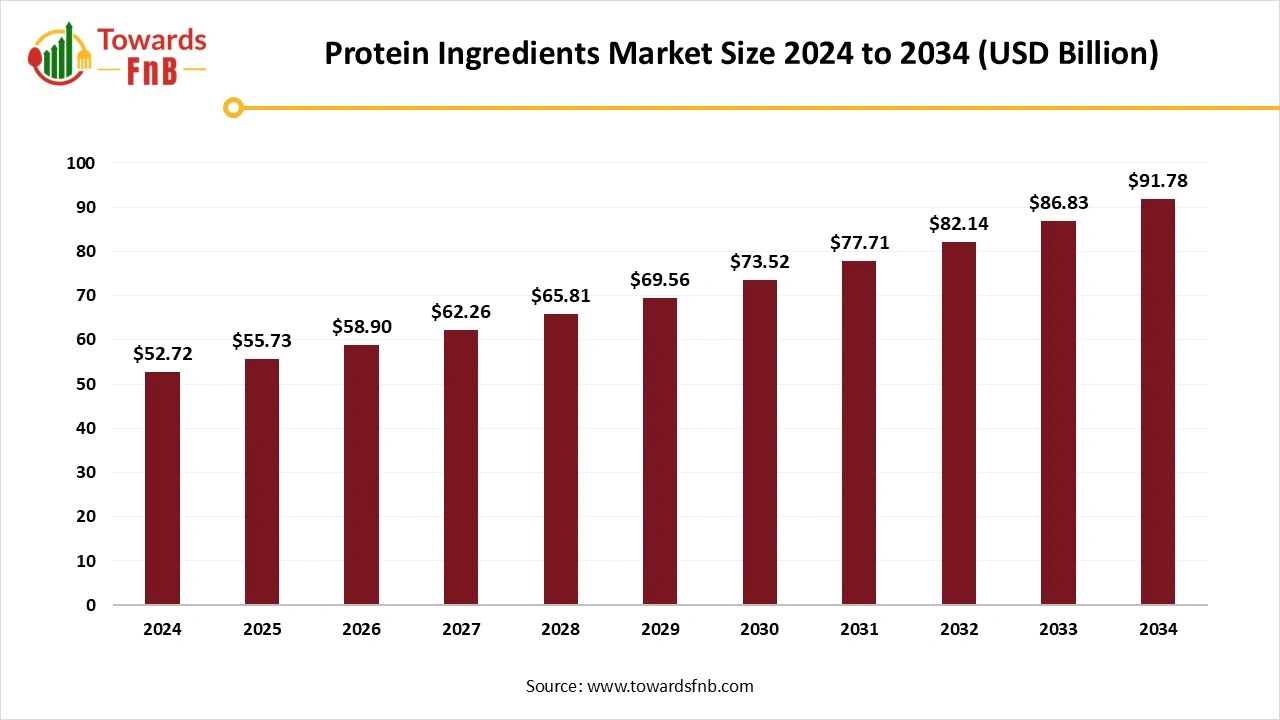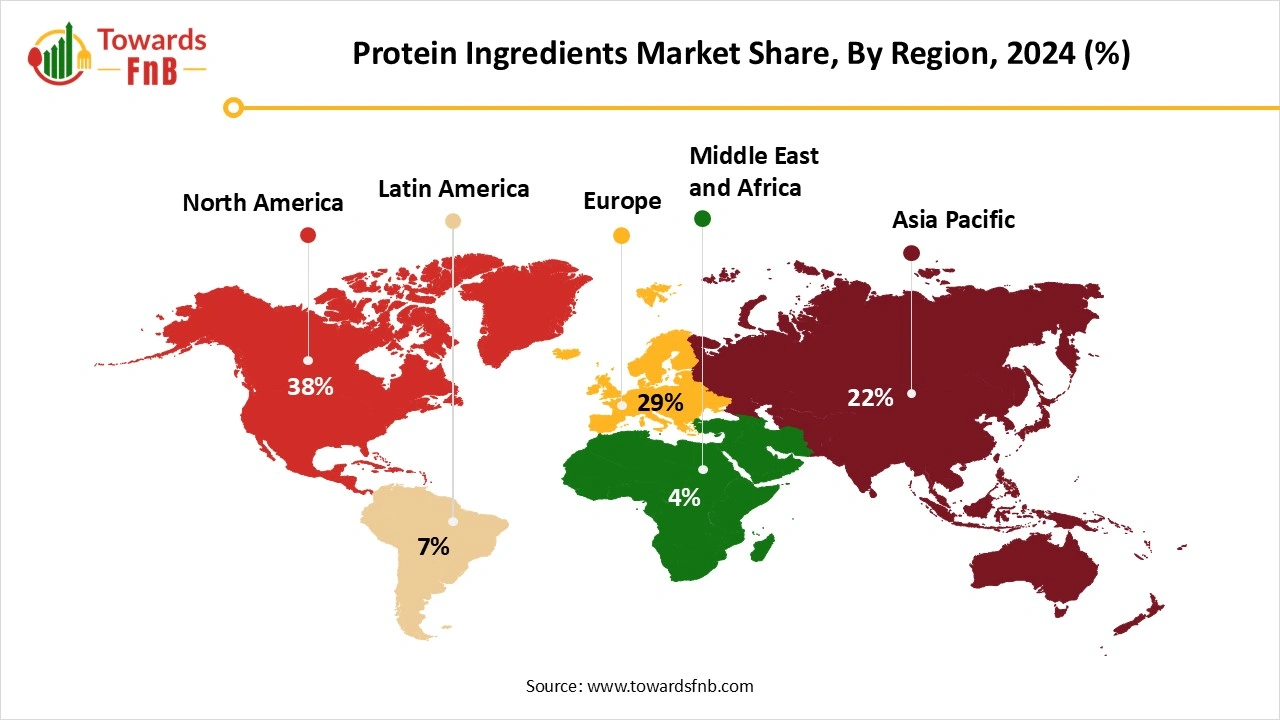November 2025
The global protein ingredients market size reached at USD 52.72 billion in 2024 and is anticipated to increase from USD 55.73 billion in 2025 to an estimated USD 91.78 billion by 2034, witnessing a CAGR of 5.7% during the forecast period from 2025 to 2034. The market is driven by increasing consumer preference for high-protein foods.

| Study Coverage | Details |
| Growth Rate from 2025 to 2034 | CAGR of 5.8% |
| Market Size in 2025 | USD 55.73 Billion |
| Market Size in 2026 | USD 58.90 Billion |
| Market Size by 2034 | USD 91.78 Billion |
| Largest Market | North America |
| Base Year | 2024 |
| Forecast Period | 2025 to 2034 |
| Regions Covered | North America, Europe, Asia-Pacific, Latin America, and Middle East & Africa |
The protein ingredients market is driven by growing consumer preference for animal-free and plant-based options, rising consumption of dietary supplements, increasing demand for functional foods, greater awareness of health and wellness, and stronger interest in vegan and vegetarian lifestyles. In addition, the expanding availability of plant-based protein sources such as lentils, peas, and soy, along with a heightened focus on ethical sourcing and sustainability, is expected to further support market growth during the forecast period.
Key technological shifts in the protein ingredients market revolve around precision fermentation, non-thermal processing, enzymatic modification, and advanced extraction methods that enhance protein functionality, purity, and sustainability. Emerging tools like AI and machine learning accelerate product development by optimizing formulations and predicting consumer preferences. Technologies such as microencapsulation and 3D printing improve protein delivery, stability, and texture, making alternative proteins more appealing. Together, these advancements reduce production costs, expand application possibilities, and support the large-scale commercialization of next-generation protein solutions, driving strong market growth.
Raw Material Sourcing
Processing & Extraction
Formulation & Product Development
Packaging & Branding
Distribution & Logistics
What Made North America the Dominant Region in the Protein Ingredients Market?
North America dominated the global market with the largest revenue share in 2024. The region's dominance in the market is attributed to rising demand for ready-to-eat protein sources, a strong sports nutrition culture, and consumer preferences for convenience and longer shelf life driven by busy lifestyles. Additionally, the expansion of e-commerce platforms, the growing demand for fortified and functional foods, and the increasing awareness of the benefits and needs of nutrition. The U.S. and Canada are the key countries driving market growth in this region.
U.S. Protein Ingredients Market Trends
The U.S. dominates the protein ingredients industry, driven by the growing popularity of high-protein diets such as paleo and keto, rising health awareness among consumers, rapid urbanization, and fast-paced lifestyles. Additionally, increasing demand for protein-rich food products, expansion of the food processing industry, and innovation in ready-to-drink beverages and protein-rich snacks contribute to market growth. Furthermore, strong investment and regulatory support for food technology make the U.S. a global leader in the food processing sector.

What Makes Asia Pacific the Fastest-Growing Region in the Market?
Asia Pacific is expected to grow at the fastest rate during the forecast period. Market growth in the region is driven by changing consumer lifestyles, rising demand for convenient and ready-to-cook options, and increasing preference for organic and plant-based food. Additional factors include government support for food innovation, rapid urbanization, growing fitness culture, higher disposable incomes, and increasing health awareness. China, India, Japan, and South Korea are the key countries driving growth in this region.
India Protein Ingredients Market Trends
India is a major contributor to the market in Asia Pacific, driven by increasing demand for ready-to-eat meals, convenience, and longer shelf-life products. As the largest global producer of milk, pulses, and jute, India benefits from a strong agricultural base. Growing interest from international importers, combined with innovation in sustainable food products, is positioning India as a key exporter of plant-based proteins.
Protein Ingredients Industry’s Regulatory Landscape in India
| Country | Regulatory Body | Key Regulations | Focus Areas | Notable Notes |
| India | Food Safety and Standards Authority of India (FSSAI) | Food Safety and Standards (Packaging and Safety Regulations) and Licensing and Registration of Food Businesses) | The protein ingredients market focuses on the protein-rich and vegan food industries, as well as on biotechnology, sustainability, and health and wellness. The market also focuses on consumer health, dietary supplements, and functional foods due to a rich nutritional profile. | Protein ingredients are widely used in natural and protein-rich food products for their capacity to enhance the efficiency, consistency, and quality of high-quality food products, and to support the consumer's immune system and health and wellness. |
Europe: A Notably Growing Region
Europe is expected to grow at a notable rate during the forecast period. Market growth in the region is driven by the rising vegetarian and vegan population, demand for extended shelf-life and reduced spoilage, and the need for convenient food solutions for both businesses and consumers. Additional factors include busy lifestyles, increasing focus on clean-label and sustainable products, and growing demand for ready-to-make and ready-to-eat meals. Germany, the UK, and France are the key countries driving growth in the region.
Germany Protein Ingredients Market Trends
In Germany, the market is driven by factors such as a strong organic food industry and growing consumer demand for processed, healthy options. Additionally, increasing environmental awareness, higher demand for ready-to-eat and convenient foods, growing popularity of high-protein snacks, bakery product, and meat alternatives, as well as rapid urbanization, contribute to market growth.
What are the Opportunities in the Middle East and Africa (MEA)?
The Middle East and Africa (MEA) region presents significant opportunities in the protein ingredients market, driven by rising demand for fortified foods, changing dietary preferences, and growing urbanization. Additionally, increasing disposable incomes, a rapidly expanding vegan population, and heightened consumer awareness of nutrition and health-related issues create immense opportunities. South Africa, the UAE, Saudi Arabia, and Kuwait are the key countries fueling growth in the region.
South Africa Protein Ingredients Market Trends
The protein ingredients industry in South Africa is driven by a growing vegetarian and vegan population, increasing consumer preference for clean-label and high-quality protein-rich products, and rising health awareness. Moreover, there is a strong focus on healthy living, wellness, immunity, and weight management, which is expected to further boost market growth in the country.
Latin America Processed Ingredients Market Trends
The market for protein ingredients in Latin America is driven by rising demand for ready-to-eat and high-protein food options, increasing production and consumption of both animal and plant proteins, and growing investment in food processing infrastructure. The rising demand for protein-rich foods, particularly in Brazil and Argentina, further supports market growth. Brazil, Mexico, and Argentina are the major countries driving the regional market.
Mexico Protein Ingredients Market Trends
The market in Mexico is experiencing rapid growth, driven by rising disposable incomes, changing consumer lifestyles, increased government focus on domestic protein production and food safety, and rapid urbanization. Additional growth factors include rising consumer demand for protein-rich foods and increased awareness of health and wellness.
Why did the Animal/Dairy Protein Ingredients Segment Dominate the Market?
The animal/dairy protein ingredients segment dominated the protein ingredients market with the largest share in 2024. This dominance is driven by technological advancements in product development and processing, along with strong demand from the animal feed, pharmaceutical, and food & beverage industries. The growing use of dairy proteins in functional foods and sports nutrition, combined with increasing consumer preference for high-protein diets and heightened health awareness, has further fueled segmental growth. Additionally, consumers’ focus on weight management, muscle development, and overall health continues to drive demand for animal and dairy protein ingredients.
The Insect Protein Segment is Expected to Grow at the Fastest CAGR During the Forecast Period.
This growth is driven by increasing demand for eco-friendly and sustainable protein alternatives, as insects require less feed, water, and land while producing lower greenhouse gas emissions. In addition, insect protein offers high nutritional value, including essential minerals, vitamins, and amino acids, and is easily digestible. Factors such as rapid urbanization, rising consumer awareness of health and nutrition, and growing interest in sustainable protein sources are further expected to propel segmental growth.
The plant protein segment is expected to grow at a significant rate during the forecast period. The growth of this segment is driven by rising consumer demand for healthier diets, increasing prevalence of chronic diseases, and greater awareness of the health benefits of plant-based diets. Additional factors include improvements in taste and texture, advancements in food technology, and a growing consumer focus on ethical, environmental, and health-conscious choices.
How Does the Food & Beverages Segment Lead the Protein Ingredients Market?
The food & beverages segment led the market with the highest share in 2024. The segment’s dominance is attributed to rising consumer demand for functional food and high-protein products, including baked goods, dairy alternatives, ready-to-drink beverages, and snacks, as well as the overall expansion of the food and beverage industry. Additionally, protein ingredients enhance product characteristics such as moisture retention, volume, and texture, further boosting their demand within this sector.
The Animal Feed Segment is Expected to Expand at the Fastest Rate During the Forecast Period.
This growth is driven by increasing consumer focus on cost-effectiveness, sustainability, and animal nutrition, along with rising demand for animal-based products, higher disposable incomes, and rapid population growth. Technological advancements in feed formulation and a greater emphasis on livestock health are also fueling market expansion. Moreover, the rising need for cost-effective, high-quality feed solutions that support healthy, productive livestock supports segmental growth.
The infant formulations segment is expected to grow at a notable rate during the forecast period. Growth in this segment is driven by rising demand for safe and transparent products, increasing parental awareness of the importance of early-life nutrition, and growing working populations. Additional factors include rising birth rates and increasing demand for high-quality infant formula that supports proper growth and development.
Tetra Pak
CFTRI
By Product
By Application
By Region
November 2025
November 2025
November 2025
November 2025